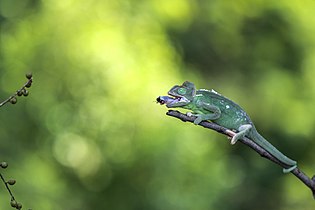
Chameleon
Chameleons or chamaeleons (family Chamaeleonidae) are a distinctive and highly specialized clade of Old World lizards with 200 species described as of June 2015.[1] The members of this family are best known for their distinct range of colours, being capable of colour-shifting camouflage. The large number of species in the family exhibit considerable variability in their capacity to change colour. For some, it is more of a shift of brightness (shades of brown); for others, a plethora of colour-combinations (reds, yellows, greens, blues) can be seen.
This article is about the reptile. For other uses, see Chameleon (disambiguation).
Chameleons are also distinguished by their zygodactylous feet, their prehensile tail, their laterally compressed bodies, their head casques, their projectile tongues used for catching prey, their swaying gait,[2] and in some species crests or horns on their brow and snout. Chameleons' eyes are independently mobile, and because of this the chameleon’s brain is constantly analyzing two separate, individual images of its environment. When hunting prey, the eyes focus forward in coordination, affording the animal stereoscopic vision.
Chameleons are diurnal and adapted for visual hunting of invertebrates, mostly insects, although the large species also can catch small vertebrates. Chameleons typically are arboreal, but there are also many species that live on the ground. The arboreal species use their prehensile tail as an extra anchor point when they are moving or resting in trees or bushes; because of this, their tail is often referred to as a "fifth limb". Depending on species, they range from rainforest to desert conditions and from lowlands to highlands, with the vast majority occurring in Africa (about half of the species are restricted to Madagascar), but with a single species in southern Europe, and a few across southern Asia as far east as India and Sri Lanka. They have been introduced to Hawaii, California, and Florida.[1][3]
Classification
In 1986, the family Chamaeleonidae was divided into two subfamilies, Brookesiinae and Chamaeleoninae.[10] Under this classification, Brookesiinae included the genera Brookesia and Rhampholeon, as well as the genera later split off from them (Palleon and Rieppeleon), while Chamaeleoninae included the genera Bradypodion, Calumma, Chamaeleo, Furcifer and Trioceros, as well as the genera later split off from them (Archaius, Nadzikambia and Kinyongia). Since that time, however, the validity of this subfamily designation has been the subject of much debate,[11] although most phylogenetic studies support the notion that the pygmy chameleons of the subfamily Brookesiinae are not a monophyletic group.[12][13][14][15]
While some authorities have previously preferred to use this subfamilial classification on the basis of the absence of evidence principle,[11] these authorities later abandoned this subfamilial division, no longer recognizing any subfamilies with the family Chamaeleonidae.[16]
In 2015, however, Glaw reworked the subfamilial division by placing only the genera Brookesia and Palleon within the Brookesiinae subfamily, with all other genera being placed in Chamaeleoninae.[1]
Reproduction
Most chameleons are oviparous, but all Bradypodion species and many Trioceros species are ovoviviparous (although some biologists prefer to avoid the term ovoviviparous because of inconsistencies with its use in some animal groups, instead just using viviparous).[56]
The oviparous species lay eggs three to six weeks after copulation. The female will dig a hole—from 10–30 cm (4–12 in), deep depending on the species—and deposit her eggs. Clutch sizes vary greatly with species. Small Brookesia species may only lay two to four eggs, while large veiled chameleons (Chamaeleo calyptratus) have been known to lay clutches of 20–200 (veiled chameleons) and 10–40 (panther chameleons) eggs. Clutch sizes can also vary greatly among the same species. Eggs generally hatch after four to 12 months, again depending on the species. The eggs of Parson's chameleon (Calumma parsoni) typically take 400 to 660 days to hatch.[57]
Chameleons lay flexible-shelled eggs which are affected by environmental characteristics during incubation. The egg mass is the most important in differentiating survivors of Chameleon during incubation. An increase in egg mass will depend on temperature and water potential.[58] To understand the dynamics of water potential in Chameleon eggs, the consideration of exerted pressure on eggshells will be essential because the pressure of eggshells play an important role in the water relation of eggs during entire incubation period [59]
The ovoviviparous species, such as the Jackson's chameleon (Trioceros jacksonii) have a five- to seven-month gestation period. Each young chameleon is born within the sticky transparent membrane of its yolk sac. The mother presses each egg onto a branch, where it sticks. The membrane bursts and the newly hatched chameleon frees itself and climbs away to hunt for itself and hide from predators. The female can have up to 30 live young from one gestation.[60]
Chameleons are preyed upon by a variety of other animals. Birds and snakes are the most important predators of adult chameleons. Invertebrates, especially ants, put a high predation pressure on chameleon eggs and juveniles.[64] Chameleons are unlikely to be able to flee from predators and rely on crypsis as their primary defense.[65] Chameleons can change both their colours and their patterns (to varying extents) to resemble their surroundings or disrupt the body outline and remain hidden from a potential enemy's sight. Only if detected, chameleons actively defend themselves. They adopt a defensive body posture, present an attacker with a laterally flattened body to appear larger, warn with an open mouth, and, if needed, utilize feet and jaws to fight back.[66] Vocalization is sometimes incorporated into threat displays.[64]
Parasites
Chameleons are parasitized by nematode worms, including threadworms (Filarioidea). Threadworms can be transmitted by biting insects such as ticks and mosquitoes. Other roundworms are transmitted through food contaminated with roundworm eggs; the larvae burrow through the wall of the intestine into the bloodstream.[67]
Chameleons are subject to several protozoan parasites, such as Plasmodium, which causes malaria, Trypanosoma, which causes sleeping sickness, and Leishmania, which causes leishmaniasis.[68]
Chameleons are subject to parasitism by coccidia,[68] including species of the genera Choleoeimeria, Eimeria, and Isospora.[69]







